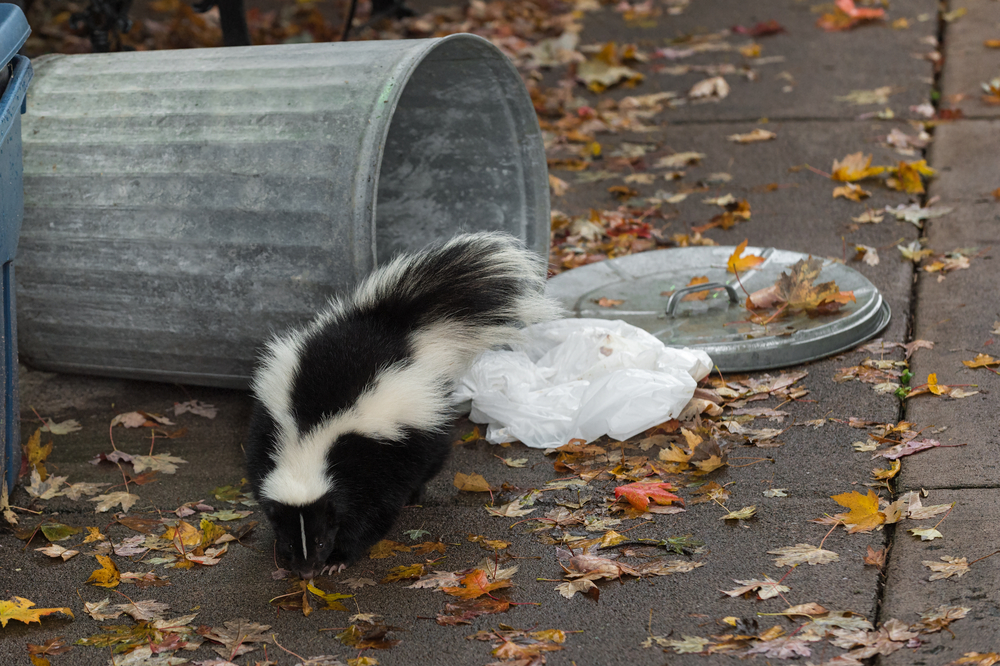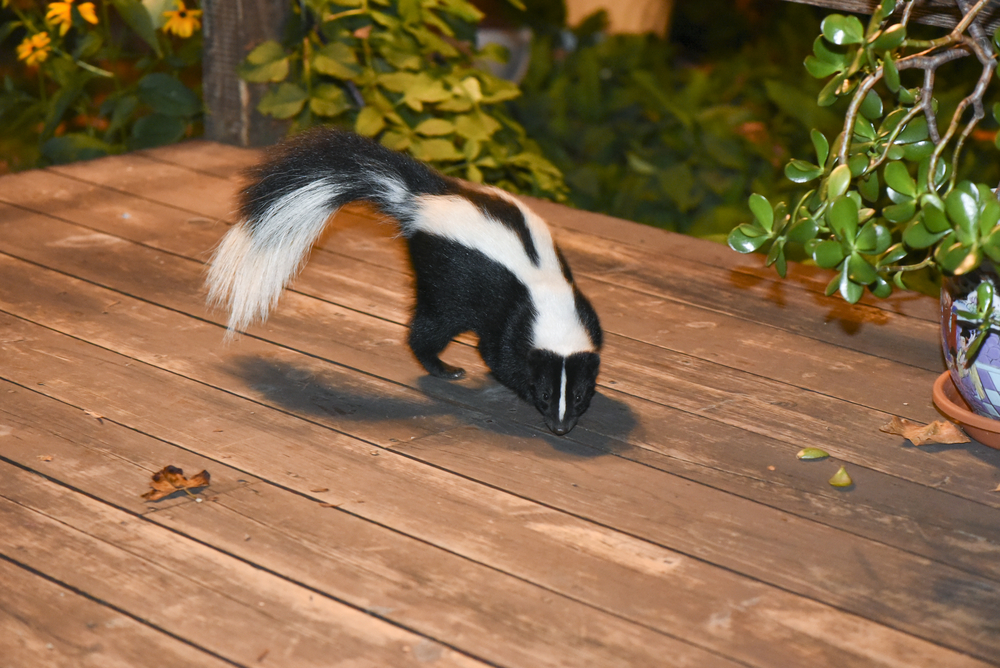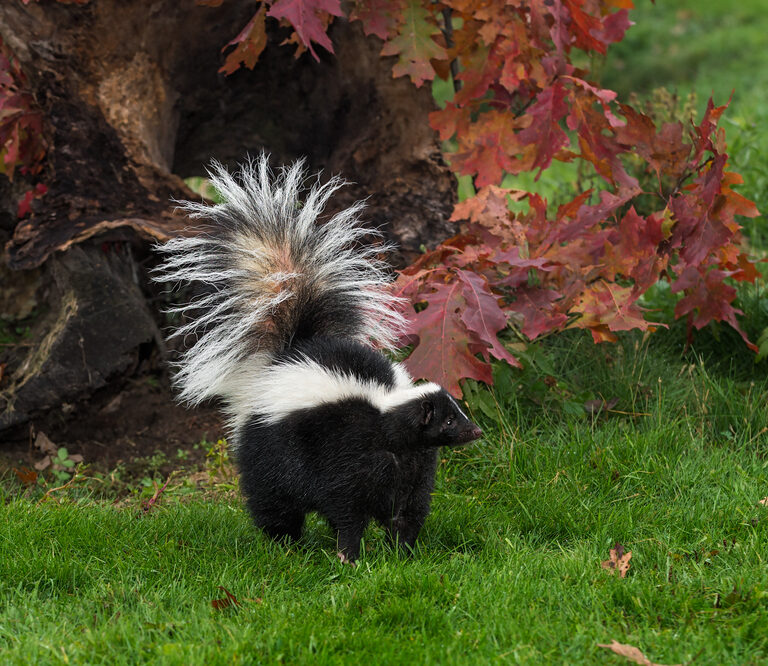Infamous for their foul spray, skunks are a familiar foe in many parts of the U.S. From woodlands, farmlands, and urban areas (and even beaches), it is not uncommon to find these little animals getting up to mischief at night. Even if you can’t see them, you can tell one has been close by from the distinctive musky smell they leave behind.
While they only spray when they feel threatened, their abundance in urban areas means you’re more than likely to stumble upon one without even knowing. Besides, these animals regularly nest in hidden places underneath houses, decks, and woodpiles in yards.
If it seems like these little rascals have made a nightclub out of your property, it’s time to take matters into your own hands. Here are some practical ways to get rid of skunks and prevent them from showing up again in your yard.
The 8 Best Ways to Get Rid of Skunks
Here are our favorite strategies for freeing yourself from that skunky stench.
1. Cut Their Food Supply
Skunk eat pretty much everything from small rodents to insects, fruits, and nuts. Even if you tackle one of their food sources, chances are they’ll find something else nearby. The trick is to limit their options, making them look for easier food sources outside of your premises.
Here are some quick tips to get you started:
- Make sure that they’re not getting into your garbage. Keep trash cans properly closed and ensure everything is stored in sealed bags, especially at night.
- If you have pets, make sure their food plates are always kept inside your house.
- Bird feeders also attract skunks, so you may have to empty these for a while until the skunks leave for good.
- Pick up any fruits that have fallen to the ground from nearby trees.

2. Block off Their Shelters
Skunks typically nest in bushy green areas. Still, they are also known for making shelters underneath houses and decks. Check all sides of your home and its surrounding areas. Leave no stone unturned, as they usually dig their dens under buildings and woodpiles.
Block any entrance or space they may crawl into with some wood or plastic fencing. They’ll quickly get the message and leave if they can’t find a new route.
Skunks use underground dens pretty much all year, but female skunks usually give birth in late April or May. Be especially vigilant when you’re sealing entrances around these months, so you don’t trap the mother and her babies inside their dens.
Be careful while poking around any hole; although it’s rare, skunks can carry rabies, which they transmit through a bite. If you’re bitten by any wild animal during your search, seek medical help immediately.
3. Light up Their World
For the most part, skunks are nocturnal animals that move around under the cover of darkness. Another effective way to keep them away from your property is to install motion-activated lights, as they get startled pretty easily by light sources.
With a couple of good scares, the skunk will prefer the peace of a different route rather than setting foot on your property again.
4. Buy a Commercial Repellent
Despite their spray’s foul smell, these animals are ironically very snobby about the scents they like. Many commercially available repellents are very effective and use various scents that skunks despise, such as peppermint.
If you have pets or small children, make sure to pick something that doesn’t include toxic chemicals such as naphthene, which can cause harmful effects.
5. Make a Homemade Repellent
You can also cook up your own repellent by boiling yellow onion together with jalapenos for about 20 minutes. Fill a spray bottle with the mixture, then add a tablespoon of cayenne. Shake the bottle a little bit, and spray around the areas where skunks may wander, like the trash cans or any hole in your fence.
Skunks also try to avoid places that have the smell of urine from their predators. If you’re adventurous enough, you can also use kitty litter from your pets and spread it around the skunk’s preferred areas. This unconventional method flushes the animal out from its nest, allowing you to seal it.
However, you should know that most commercially available urine-based repellents are not sourced humanely, so try to avoid those.
6. Set up Fences
Skunks are terrible climbers, let alone jumpers, so a fence that’s a few feet taller than them might just do the trick. However, they are really good at digging, so you’ll want to make sure that the fence also goes a few feet underground.
If you already have a fence, but skunks keep getting inside, you need to check again for holes or crawl spaces, as they will take advantage of any area they can fit into. They usually patrol pre-established areas around two miles from their dens.
If you can, block off your property, they’ll leave and go to another place with an easier path.
7. Trap Them (Carefully)
If you decide to take on this task, remember that direct contact is a no-no. First, you need to consult with your local wildlife authority regarding regulations for trapping and releasing wildlife. You will also need a trap designed specifically for skunks because you don’t want their spray to leak.
The best way to attract the animal is with bait, so a can of tuna, insects, or fruit will work. Set the trap overnight in the area where you think the skunk is dwelling or passing. Remember to always wear protective equipment like gloves and glasses, and a set of clothes you don’t mind throwing away in case of an accident.
Once you have captured the intruder, please take it to the area that your local authorities recommend, then carefully open the trap. Take several steps backs and wait for the skunk to leave so that you can safely retrieve the trap.
8. Call a Professional
If you are unlucky enough to have found a mother and her litter, relocation is your best bet. You should know that trapping a skunk, let alone several, is not an easy feat. For that reason, in this case, it’s better to enlist the help of a professional.
Someone with experience will trap the skunk with ease and be able to transport and release it at a safe place, outside of urban areas.
Prevention
Skunks have pre-established routes they deem safe and like to take. The reason they may have taken a liking to your property is that they have found shelter or food around it.
The good news is that, unlike other persistent animals like raccoons and rats, our little black and white intruders are not lingerers. Once you take care of their food source or shelter, they’ll quickly move on with their lives elsewhere.
How to Get Rid of Skunk Smell?

Trying to remove these critters from your property comes with its fair share of risk. In case you or your pets get sprayed, you should know that using things like tomato juice, oatmeal, and beer to remove the smell is nothing but a myth. What really happens is that the odor from these products is so intense, it momentarily tricks your sense of smell, but you better believe that it still stinks.
Instead, put your clothes in the washer with a mix of detergent and half a cup of baking soda. As for yourself, it’s time to take a bath. Use dish detergent instead of soap. You may end up smelling like clean dishes, but it beats the alternative.
When it comes to pets, a mix of shampoo with baking soda and a little bit of oxygen peroxide should do the trick. However, make sure it doesn’t get into their eyes when you’re bathing them. You should also make sure that you don’t let the mixture sit on your pet for more than five minutes because the oxygen peroxide can lighten your pet’s fur.
Final Thoughts
In the end, getting rid of skunks is all about being mindful and observant. Following the above steps will help you get rid of skunks, but also reduce the chances of other animals wandering through your property. Once you stop noticing their presence of skunks, you can take a deep breath and enjoy the sweet smell of victory.
